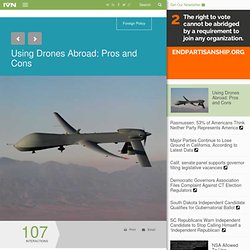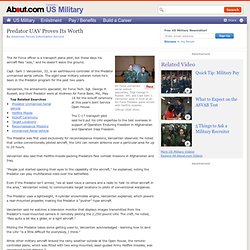

Benefits, Risks And Ethical Concerns Of Drones. The US and its UAVs: A Cost-Benefit Analysis. Using Drones Abroad: Pros and Cons. Coverage of drones in the American news media borders on either fear-mongering or near-total silence.

How can voters form intelligent opinions about drones and the effects of their domestic and foreign use when, many times, media outlets only discuss how the machines relate to everyday Americans? Drones: The Future of Warfare? Since President Obama took office, the use of and hype surrounding drones has greatly increased.

Obama has conducted more than three times as many drone strikes per year compared to his predecessor in the White House.[1] The increase use of drones points to a potential revolution in warfare, or at least a shift in the perspective of how wars will be fought in the future. As robotics expert P.W. Singer argues, “the introduction of unmanned systems to the battlefield doesn’t change simply how we fight, but for the first time changes who fights at the most fundamental level. It transforms the very agent of war, rather than just its capabilities.”[2]
Predator UAV Proves Its Worth. The Air Force officer is a transport plane pilot, but these days his aircraft flies "solo," and he doesn't leave the ground.

Capt. Sam J. Vanzanten, 32, is an earthbound controller of the Predator unmanned aerial vehicle. January 2012: How Drones Are Changing Warfare. Technology is to politics as the weather is to sports: We can’t really control it, but we certainly have to live with it.

In recent years the technology of unarmed aerial vehicles has made tremendous strides, allowing modern warfare to be conducted in many respects by remote control. This may seem like a boon to technologically savvy countries like the United States, and in a sense it clearly is. But the moral calculus of war is rarely that simple: While drones can and do shield front-line troops from danger, and can often substitute for them entirely, they also have other effects.
Drones can make it more likely that we will enter into wars, for example, and if so, then it’s no longer clear that they help the ordinary soldier. Drones may increase casualties among noncombatants; their pinpoint accuracy is only as good as the human intelligence behind them, which now may be more subject to manipulation, not less. The Pros and Cons of Drones. Drones have received a lot of publicity lately in the nightly news, and I have noticed many inconsistencies about them that I would like to clear up.

First, drones have many different names. Typically, they are often referred to as "killer drones" and "attack drones"; however, they are also sometimes called "spy drones” or "surveillance drones". Note that these more detailed names may imply restricted functionality; however, they may not. Thus, they do cause some minor confusion. The most technically accurate name for a drone is an unmanned aerial vehicle or UAV for short. And drones can be both remote controlled by a pilot and/or controlled by a computer.
The Moral Case for Drones. U.S. military turns to drones as next-generation fighters. Monday, 20 June 2011 11:28 News & Events - Engineering News The U.S. military has been at the forefront of technological innovation for a majority of its history, and as officials push for a reduction in deployed troops, researchers are working on developing drones - some the size of a fingernail - that can be used in combat, the New York Times reports.

Learn to Stop Worrying and Love the Drones. Unmanned aerial vehicles (UAVs) are most commonly referred to as drones, but other names such as “killer robot” and “Big Brother in the sky” have surfaced.

Regardless of what they’re called, one thing is clear: drones are here to stay and will increasingly be used for nonmilitary, domestic applications. The Federal Aviation Administration estimates that there will be 30,000 drones in U.S. airspace within the next 20 years (PDF). The news of future drone proliferation has sparked controversy and among many Americans who have legitimate safety and privacy concerns, but narrowly view drones as either spying or overseas killing machines. Unmanned Aerial Vehicle Systems Association Advantages of UAVs.
Drone Wars. A United States Air Force Predator aircraft at Kandahar Air Field, Kandahar, June 5, 2006.

David Bathgate/Corbis. Drones: A New Chapter in Modern Warfare. Less than a month had passed since the United States mourned the victims of 9/11 when American born al-Qaeda cleric, Anwar al-Awlaki, fell neither at the hands of Yemeni authorities nor through the swiftest measure of justice dragged out... more Less than a month had passed since the United States mourned the victims of 9/11 when American born al-Qaeda cleric, Anwar al-Awlaki, fell neither at the hands of Yemeni authorities nor through the swiftest measure of justice dragged out in the courtroom.

It should come as no surprise that the targeted killing of al-Awlaki, more precisely the CIA drone strike on his vehicle well within Yemeni borders, has become highly politicized – the limelight perhaps – behind this new chapter in modern warfare. Download (.pdf) Share. Drone Technology In Everyday Applications: Not Just For The Military Anymore. Drones are no longer a technology of the future.

They are being manufactured and used in a variety of applications, but the most common is aerial surveillance and intelligence including border control. Up until now, the military has been the primary market for drone technology, using it to track down and kill suspected Al Qaeda members. Why Drones Work: The Case for Washington's Weapon of Choice. Despite President Barack Obama’s recent call to reduce the United States’ reliance on drones, they will likely remain his administration’s weapon of choice. Whereas President George W. Bush oversaw fewer than 50 drone strikes during his tenure, Obama has signed off on over 400 of them in the last four years, making the program the centerpiece of U.S. counterterrorism strategy.
The drones have done their job remarkably well: by killing key leaders and denying terrorists sanctuaries in Pakistan, Yemen, and, to a lesser degree, Somalia, drones have devastated al Qaeda and associated anti-American militant groups. And they have done so at little financial cost, at no risk to U.S. forces, and with fewer civilian casualties than many alternative methods would have caused.
EXPO-DROI_ET(2013)410220_EN.pdf?currentTermId=7&sidesGetDoc=http%3A%2F%2Fwww.europarl.europa.eu%2Fsides%2FgetDoc.do&urlForLocaleChange=%2Fstudiesdownload.html%3Ffile%3D92953%26languageDocument%3DEN&impContribLibrary=http%3A%2F%2Fwww.europarl.europa.eu%2Fr. The Pros and Cons of Killer Robots. Hamas and Fatah leaders have announced they’re going to work together after years of animosity, but their rank and file have been cooperating for a long time—in Israeli prisons.
RAMALLAH, West Bank—Leaders of Hamas and Fatah announced this week that they have reached an agreement for reconciliation after years of division, drawing furious condemnation from the Israeli government. But the choice of peace between Fatah in the West Bank and Hamas in Gaza is nothing new for those who have languished together and suffered together in Israel’s jails. As many as 40 per cent of all Palestinian men have done time in Israeli prisons, and along with the physical and emotional scars of incarceration, the solidarity among prisoners does not simply disappear once they are released. 2_Article_Terrill. Ask the experts: Drones. This week’s show raises a number of questions related to how the American drone strategy in Pakistan (and elsewhere) creates potential tensions in the region. To help sift through these complex issues, we asked leading experts to weigh in on drone warfare. Understanding Drones. Drones are quickly becoming one of the U.S. military's primary weapons.
Here is what you need to know about them. Predator Drone Copyright © U.S. Air Force.